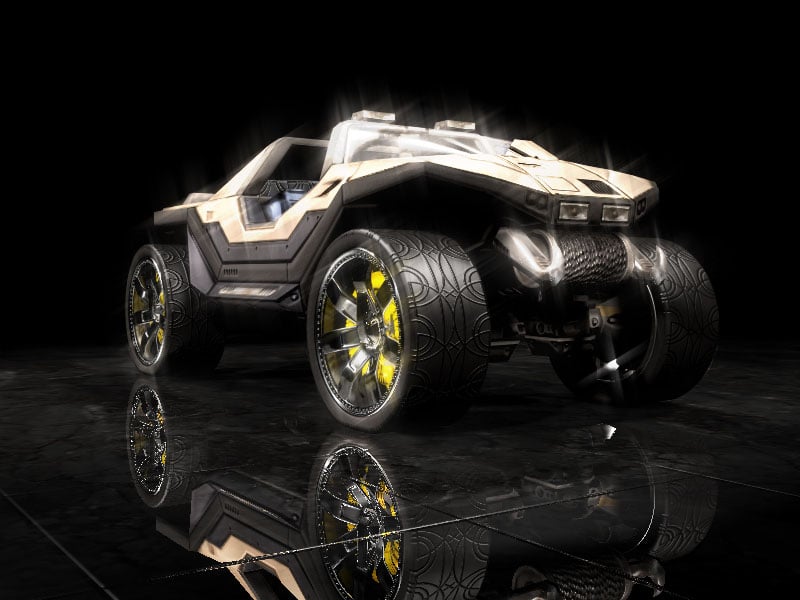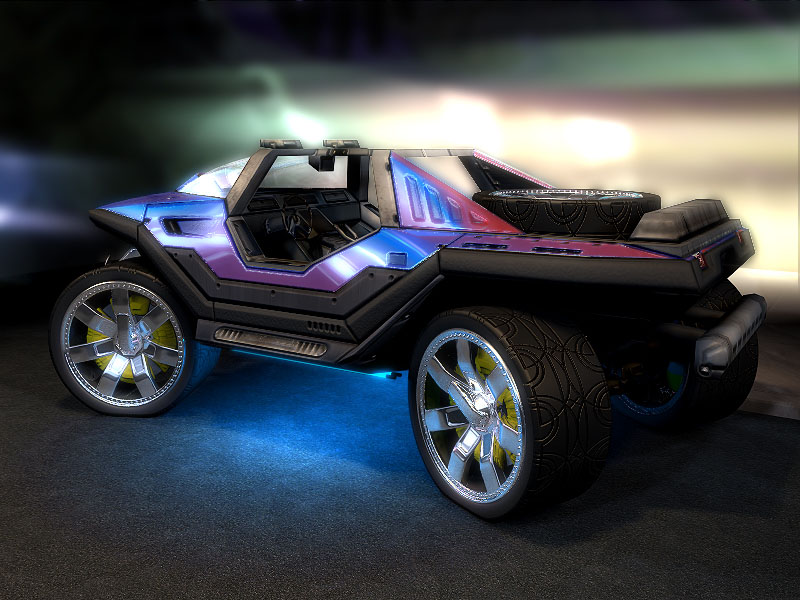Car & Pilot: December 2551 Edition: Difference between revisions
From Halopedia, the Halo wiki
m (added link) |
m (Text replacement - "== ([^=])" to "== $1") |
||
| (17 intermediate revisions by 12 users not shown) | |||
| Line 1: | Line 1: | ||
{{ | {{Status|Canon}} | ||
The '''Car & Pilot: December 2551 Edition''' is a release of [[Car & Pilot Magazine]]. It had a review of the Civilian Warthog. | |||
== Review == | |||
[[File:Carpilotbanner.gif]] | |||
[[AMG Transport Dynamics]] [[Civilian Warthog|2553 Hog]]: First Review<br> | [[AMG Transport Dynamics]] [[Civilian Warthog|2553 Hog]]: First Review<br> | ||
December, [[2551]] | December, [[2551]] | ||
| Line 8: | Line 13: | ||
Photography: [[Zoe Huisman]] | Photography: [[Zoe Huisman]] | ||
As drivers move more and more toward other forms of transport - personal choppers, hydrogen skiffs and hyperlight gliders - it's nice to see that AMG Transport Dynamics is still keeping things down and dirty with the 2553 edition of the sporty Hog. This long-popular civilian take on the military stalwart features some pretty significant enhancements and upgrades for the [[2553|'53]] model year. | |||
Off world environments have lead to an upsurge in demand for capable off-road recreational vehicles, and AMG seems to have targeted the niche perfectly with its slightly tamed version of the classic Jarhead transport. | |||
Off world environments have lead to an upsurge in demand for capable off road recreational vehicles, and AMG seems to have targeted the niche perfectly with its slightly tamed version of the classic Jarhead transport. | |||
The single biggest improvement over the last revision ([[2549]]) is the massive increase per wheel in horsepower/kilowattage. As with every other iteration of the Hog, each wheel has an independent drive by wire electric engine, with power generated by a forward-housed low-profile hydrogen I/C plant. The hydrogen fuel is burned at very high temperature with a synthetic carbon/silicon catalyst to achieve even better fuel consumption. | The single biggest improvement over the last revision ([[2549]]) is the massive increase per wheel in horsepower/kilowattage. As with every other iteration of the Hog, each wheel has an independent drive by wire electric engine, with power generated by a forward-housed low-profile hydrogen I/C plant. The hydrogen fuel is burned at very high temperature with a synthetic carbon/silicon catalyst to achieve even better fuel consumption. | ||
==Flawless Handling== | === Flawless Handling === | ||
Like the last version, the new Hog features a [[Graf/Hauptman Solar/Saline Actuator|Graf/Hauptman solar/saline actuator]], and will happily convert up to 12 liters of fresh, brackish or salt water into hydrogen on the fly. Detritus is compacted on board. Efficiency has been increased dramatically however, and we were able to get a range of 200 kilometers from the overnight condensation catchments. | |||
[[File:BN AMG Civilian Hog Review 1.jpg]] | |||
Computer systems are as ever, flawless. It is almost impossible to achieve unexpected spin from any wheel under any condition. AMG Transport Dynamics claims that in simulation, each wheel can be on a different surface extreme – ice, water, oil, gravel – and still achieve perfect distribution of power. Of course, we were more than happy to put that simulation to the test at our Kentucky proving ground and we're happy to report that the Hog performed almost supernaturally well. | Computer systems are as ever, flawless. It is almost impossible to achieve unexpected spin from any wheel under any condition. AMG Transport Dynamics claims that in simulation, each wheel can be on a different surface extreme – ice, water, oil, gravel – and still achieve perfect distribution of power. Of course, we were more than happy to put that simulation to the test at our Kentucky proving ground and we're happy to report that the Hog performed almost supernaturally well. | ||
| Line 25: | Line 30: | ||
It's perfectly safe to do that thanks to excellent structural rigidity. Cushioned harnesses keep passengers tightly embraced in the cockpit, and multiple gas-inflated restraints and magnetic field cushioning gives this year's Hog the highest passenger safety rating of any current recreational passenger vehicle. | It's perfectly safe to do that thanks to excellent structural rigidity. Cushioned harnesses keep passengers tightly embraced in the cockpit, and multiple gas-inflated restraints and magnetic field cushioning gives this year's Hog the highest passenger safety rating of any current recreational passenger vehicle. | ||
==Hard, Smooth Ride== | === Hard, Smooth Ride === | ||
Tires, significantly for this year, have moved away from previous inert-gas pocket inflation, with equally burst-proof single unit nanotube skeletons. They provide the buoyancy and ride of gas-pocket tires, but are almost indestructible. As a matter of fact, they have a far higher Moh's scale rating than the carbon-steel rims they cushion. Purists will claim that nanotubes have a more jarring, vibrating ride, but [[Michelin-Vance]] claims the new skeletons should actually provide a more luxuriant and comfortable experience on plastic or mineral based highways, and far greater comfort off-road. The relatively massive tires are a joint project between Michelin-Vance and AMG, so expect to see this tech appear on other marquees. Of course, the nanotube tires mean that the spare is even more irrelevant and decorative than ever before. | Tires, significantly for this year, have moved away from previous inert-gas pocket inflation, with equally burst-proof single unit nanotube skeletons. They provide the buoyancy and ride of gas-pocket tires, but are almost indestructible. As a matter of fact, they have a far higher Moh's scale rating than the carbon-steel rims they cushion. Purists will claim that nanotubes have a more jarring, vibrating ride, but [[Michelin-Vance]] claims the new skeletons should actually provide a more luxuriant and comfortable experience on plastic or mineral based highways, and far greater comfort off-road. The relatively massive tires are a joint project between Michelin-Vance and AMG, so expect to see this tech appear on other marquees. Of course, the nanotube tires mean that the spare is even more irrelevant and decorative than ever before. | ||
| Line 33: | Line 37: | ||
Exterior colors are available to order in any hue, although the canary-yellow corporate default scheme is as popular as ever. | Exterior colors are available to order in any hue, although the canary-yellow corporate default scheme is as popular as ever. | ||
Entertainment is improved too. The acoustic dampening field means that road and engine noise are canceled completely, and the brilliant holographic audio system (something you definitely won't find in the military version) provides literally perfect music or audio entertainment and can be networked to your home | Entertainment is improved too. The acoustic dampening field means that road and engine noise are canceled completely, and the brilliant holographic audio system (something you definitely won't find in the military version) provides literally perfect music or audio entertainment and can be networked to your home play list, or simply connect to [[SiriusHub]] and access anything you like. Voice controls are of course standard, although the addition of passenger control means that your companion can access his or her own music selection with zero interference – audio field clarity is that precise. A [[vocal repeater]] allows conversations to continue uninterrupted. | ||
==Pack Light== | === Pack Light === | ||
As ever, the Hog's biggest failing is luggage capacity. Barely big enough for a first aid kit, cubbyholes and panels abound, but the only way to carry luggage for a weekend trip is to jam it behind the seats or trim your Hog with the optional luggage rack. That kit replaces the largely superfluous spare, and it makes a much more sensible option. To be fair, the vehicle was always intended as more of a daytripper than a grand tour, but much more than a pair of sunglasses and a hub-comm, and you'll be jammed in there pretty tight. | |||
[[File:BN AMG Civilian Hog Review 2.jpg]] | |||
Dynamically, the Hog is even more pleasing this year, and the aesthetic enhancements only add to its odd mixture of luxury and utility, though this is an update, not a revolution. Drivers expecting the kind of overhaul AMG demonstrated with last year's sublime relaunch of the Capri | Dynamically, the Hog is even more pleasing this year, and the aesthetic enhancements only add to its odd mixture of luxury and utility, though this is an update, not a revolution. Drivers expecting the kind of overhaul AMG demonstrated with last year's sublime relaunch of the Capri will be disappointed, but for weekend warriors seeking a hipper way to bounce through the countryside, the '53 Hog is the only way to travel. | ||
The standard model starts at a hefty 86,000 UN Credaroos. A manual-transmission version stickers at UNCr81,000., while the Limited edition wood-trimmed Classic Edition with winch, tow and luggage rack tops out at UNCr91,000. | The standard model starts at a hefty 86,000 UN Credaroos. A manual-transmission version stickers at UNCr81,000., while the Limited edition wood-trimmed Classic Edition with winch, tow and luggage rack tops out at UNCr91,000. | ||
We'll update with the results of our long-term test in the fall.<ref>http:// | We'll update with the results of our long-term test in the fall.<ref>[http://halo.bungie.net/News/content.aspx?type=topnews&cid=896 '''Bungie.net''': ''AMG Civilian Hog Review'']</ref> | ||
==See also== | |||
*[[Car & Pilot Magazine]] | *[[Car & Pilot Magazine]] | ||
*[[Civilian Warthog]] | *[[Civilian Warthog]] | ||
==Sources== | ==Sources== | ||
{{Ref/Sources}} | |||
[[Category:Books (Halo)]] | |||
Latest revision as of 14:08, April 12, 2022
The Car & Pilot: December 2551 Edition is a release of Car & Pilot Magazine. It had a review of the Civilian Warthog.
Review[edit]
AMG Transport Dynamics 2553 Hog: First Review
December, 2551
Review: Kyle Soutar
Photography: Zoe Huisman
As drivers move more and more toward other forms of transport - personal choppers, hydrogen skiffs and hyperlight gliders - it's nice to see that AMG Transport Dynamics is still keeping things down and dirty with the 2553 edition of the sporty Hog. This long-popular civilian take on the military stalwart features some pretty significant enhancements and upgrades for the '53 model year.
Off world environments have lead to an upsurge in demand for capable off-road recreational vehicles, and AMG seems to have targeted the niche perfectly with its slightly tamed version of the classic Jarhead transport.
The single biggest improvement over the last revision (2549) is the massive increase per wheel in horsepower/kilowattage. As with every other iteration of the Hog, each wheel has an independent drive by wire electric engine, with power generated by a forward-housed low-profile hydrogen I/C plant. The hydrogen fuel is burned at very high temperature with a synthetic carbon/silicon catalyst to achieve even better fuel consumption.
Flawless Handling[edit]
Like the last version, the new Hog features a Graf/Hauptman solar/saline actuator, and will happily convert up to 12 liters of fresh, brackish or salt water into hydrogen on the fly. Detritus is compacted on board. Efficiency has been increased dramatically however, and we were able to get a range of 200 kilometers from the overnight condensation catchments.
Computer systems are as ever, flawless. It is almost impossible to achieve unexpected spin from any wheel under any condition. AMG Transport Dynamics claims that in simulation, each wheel can be on a different surface extreme – ice, water, oil, gravel – and still achieve perfect distribution of power. Of course, we were more than happy to put that simulation to the test at our Kentucky proving ground and we're happy to report that the Hog performed almost supernaturally well.
One of our staff drivers did however note a tendency for the Hog to lift when thrown into difficult turns, and although wheels will adjust when they're not in contact, it is possible to flip the beast, although to be fair – predictably.
It's perfectly safe to do that thanks to excellent structural rigidity. Cushioned harnesses keep passengers tightly embraced in the cockpit, and multiple gas-inflated restraints and magnetic field cushioning gives this year's Hog the highest passenger safety rating of any current recreational passenger vehicle.
Hard, Smooth Ride[edit]
Tires, significantly for this year, have moved away from previous inert-gas pocket inflation, with equally burst-proof single unit nanotube skeletons. They provide the buoyancy and ride of gas-pocket tires, but are almost indestructible. As a matter of fact, they have a far higher Moh's scale rating than the carbon-steel rims they cushion. Purists will claim that nanotubes have a more jarring, vibrating ride, but Michelin-Vance claims the new skeletons should actually provide a more luxuriant and comfortable experience on plastic or mineral based highways, and far greater comfort off-road. The relatively massive tires are a joint project between Michelin-Vance and AMG, so expect to see this tech appear on other marquees. Of course, the nanotube tires mean that the spare is even more irrelevant and decorative than ever before.
The cabin has come in for a complete overhaul and is available in three trim levels. For those seeking the sparse, military style of the original Hog, there's a brushed steel, riveted and carbon-fiber dash. On the other end of the aesthetic spectrum is a burled walnut and nickel-silver trim, with particularly rich, realistic wood effect for a jarringly elegant juxtaposition with the vehicle's exterior. Falling somewhere between the two is a seamless black and silver finish, which is somewhat subdued compared to the other two. All three trim levels show excellent attention to detail, with beautifully addressed switchgear, upholstery and finish. All three come with a waterproof leather-substitute for easy clean up.
Exterior colors are available to order in any hue, although the canary-yellow corporate default scheme is as popular as ever.
Entertainment is improved too. The acoustic dampening field means that road and engine noise are canceled completely, and the brilliant holographic audio system (something you definitely won't find in the military version) provides literally perfect music or audio entertainment and can be networked to your home play list, or simply connect to SiriusHub and access anything you like. Voice controls are of course standard, although the addition of passenger control means that your companion can access his or her own music selection with zero interference – audio field clarity is that precise. A vocal repeater allows conversations to continue uninterrupted.
Pack Light[edit]
As ever, the Hog's biggest failing is luggage capacity. Barely big enough for a first aid kit, cubbyholes and panels abound, but the only way to carry luggage for a weekend trip is to jam it behind the seats or trim your Hog with the optional luggage rack. That kit replaces the largely superfluous spare, and it makes a much more sensible option. To be fair, the vehicle was always intended as more of a daytripper than a grand tour, but much more than a pair of sunglasses and a hub-comm, and you'll be jammed in there pretty tight.
Dynamically, the Hog is even more pleasing this year, and the aesthetic enhancements only add to its odd mixture of luxury and utility, though this is an update, not a revolution. Drivers expecting the kind of overhaul AMG demonstrated with last year's sublime relaunch of the Capri will be disappointed, but for weekend warriors seeking a hipper way to bounce through the countryside, the '53 Hog is the only way to travel.
The standard model starts at a hefty 86,000 UN Credaroos. A manual-transmission version stickers at UNCr81,000., while the Limited edition wood-trimmed Classic Edition with winch, tow and luggage rack tops out at UNCr91,000.
We'll update with the results of our long-term test in the fall.[1]


